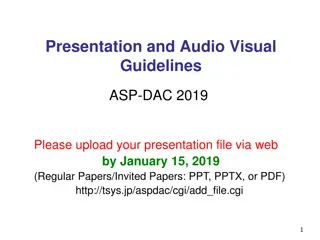Understanding the Data Formats in NEMO Phase 2
Explore the post-trigger file data format and PT file format of NEMO Phase 2, including the structure and fields of the PTHeaderInfo and EventHeader. Learn about the new data format with an ASCII-based header, its advantages, and how it relates to run setup information.
Uploaded on Dec 12, 2024 | 0 Views
Download Presentation

Please find below an Image/Link to download the presentation.
The content on the website is provided AS IS for your information and personal use only. It may not be sold, licensed, or shared on other websites without obtaining consent from the author. Download presentation by click this link. If you encounter any issues during the download, it is possible that the publisher has removed the file from their server.
E N D
Presentation Transcript
Post trigger file dataformat C. Pellegrino on behalf of the Towers TriDAS
PT file format of NEMO Phase 2 Every PostTrigger (PT) file has the following structure: PTHeaderInfo TS Header s_PTGeneralHeaderInfo + array of triggered events TriggeredEventHeaderInfo #1 Hit #1 Hit #2 The header struct must contain all the relevant informations for the off-line analysis and for the DAQ group. ... Hit #N ... TriggeredEventHeaderInfo #M Hit #1 Hit #2 ... Hit #N
Fields of PTHeaderInfo as in Phase 2 Field type Size (bit) Name Description uint 32 VersionPTFile Data format release uint 32 RunNumber The run number uint 64 StartTime5ns Start time of the run in 5ns units uint 32 MaxFileSize the maximum size for a pt-file uint 32 EffectiveFileSize the effective size of this very pt-file uint 32 FileNumber File counter for the run uint 32 TotEventsInFile uint 32 NPMTperTower the total number of PMTs in the tower uint 32 x NPMTTOWER_MAX TimeOffset [ns] Time offsets corrections uint 32 x NPMTTOWER_MAX PedestalA *1000 and converted from float to int - pedestal to be subtracted to odd samples uint 32 x NPMTTOWER_MAX PedestalB / *1000 and converted from float to int - pedestal to be subtracted to even samples uint 32 x NPMTTOWER_MAX QThreshold *1000 and converted from float to int - minimum requested (and calibrated) charge to be accepted for a trigger
Fields of EventHeader as in Phase 2 Field type Size (bit) Name Description uint 32 EventTag A constant (born date of Tommaso) uint 32 EventID The event ID uint 32 EventL The lenght of the event in Bytes uint 32 NHit Number of hits in event uint 32 Wraps Wrap index uint 32 Days Time info of the first seed uint 32 Seconds Time info of the first seed uint 32 T500us Time of the first seed in 500us unit uint 32 T10ns Time of the first seed in 10ns unit uint 32 TSCompleted Flag which specifies whether the event belongs to a completed TimeSlice uint 32 x MAXTRIGGERNUMBE R plugin_trigtype Flag that marks the presence of the plugins uint 32 x MAXTRIGGERNUMBE R plugin_nseeds Number of seeds for each plugin
New data format The part of PTHeaderInfo relative to the run setup has been replaced with a ASCII-based header (i.e. JSON). Pros: extensibility, human readable (using shell programs like head, less, strings etc...) and simply to debug. Cons: (negligible) overhead in the file size and parsing time.
The new PT file format Every PostTrigger (PT) file has the following structure: PTHeaderInfo Runsetup info (JSON) PTHeader + runsetup + array of triggered events collected by timeslices TS Header TriggeredEventHeaderInfo #1 Hit #1 The header struct must contain all the relevant informations for the off-line analysis and for the DAQ group as well as in Phase 2. Hit #2 ... Hit #N ... TriggeredEventHeaderInfo #M Hit #1 Hit #2 ... Hit #N























